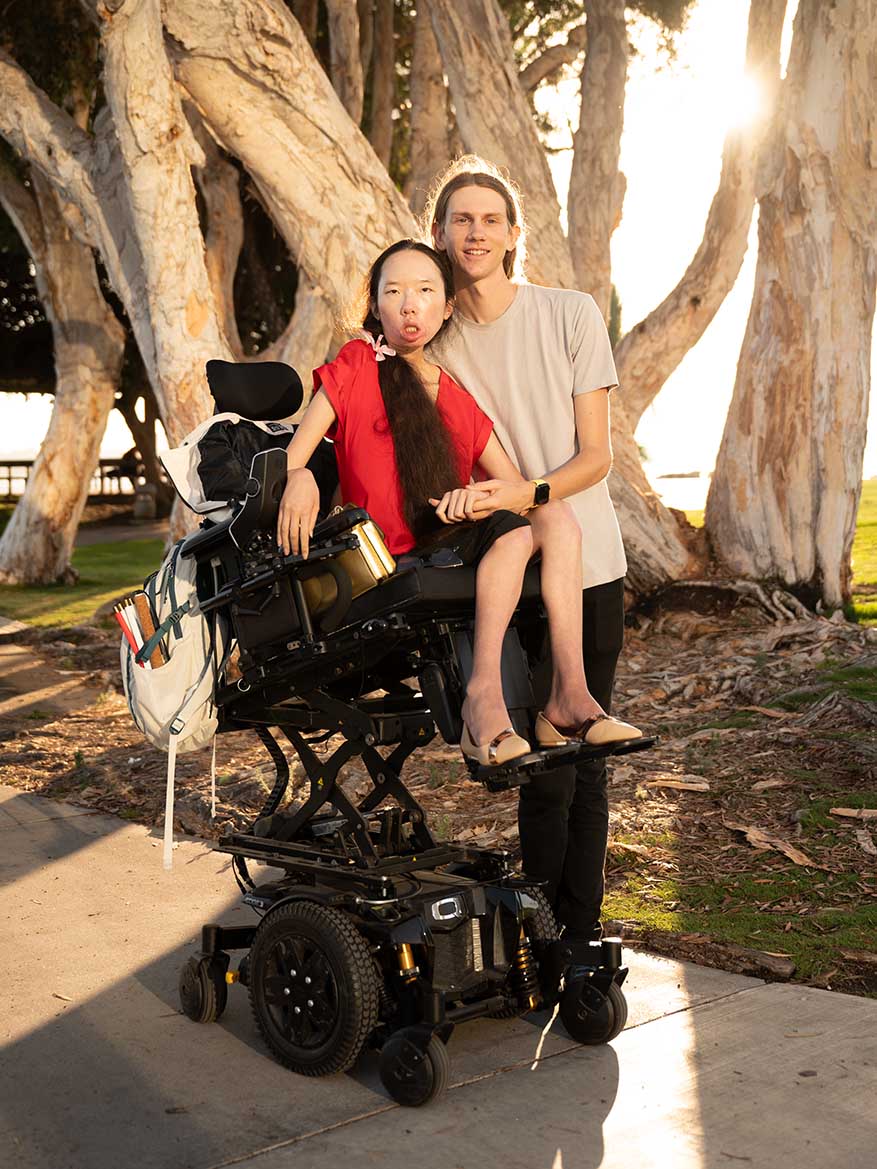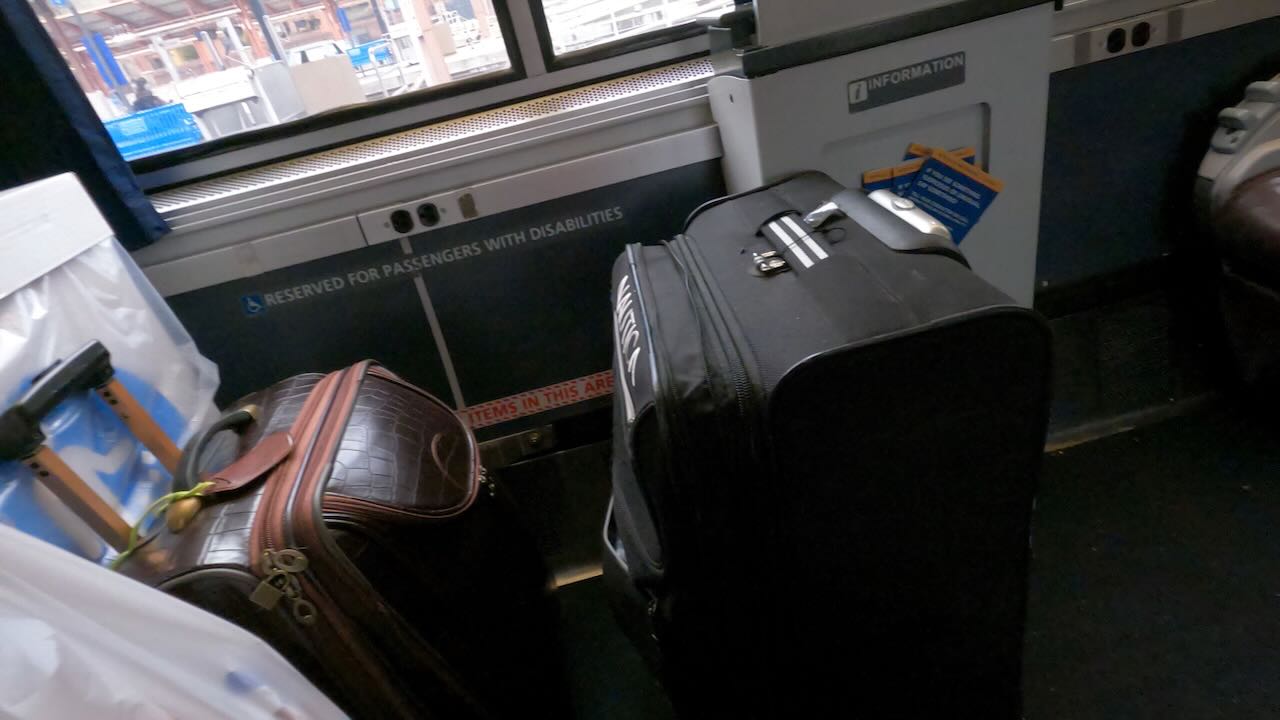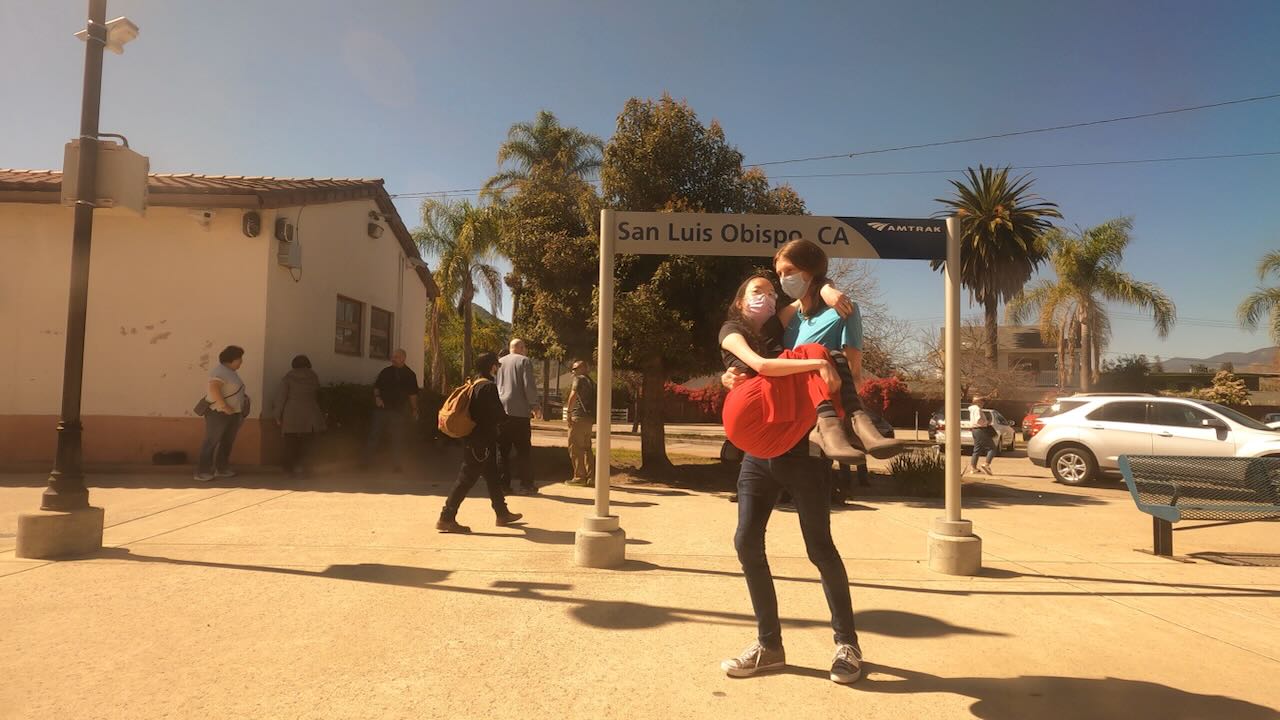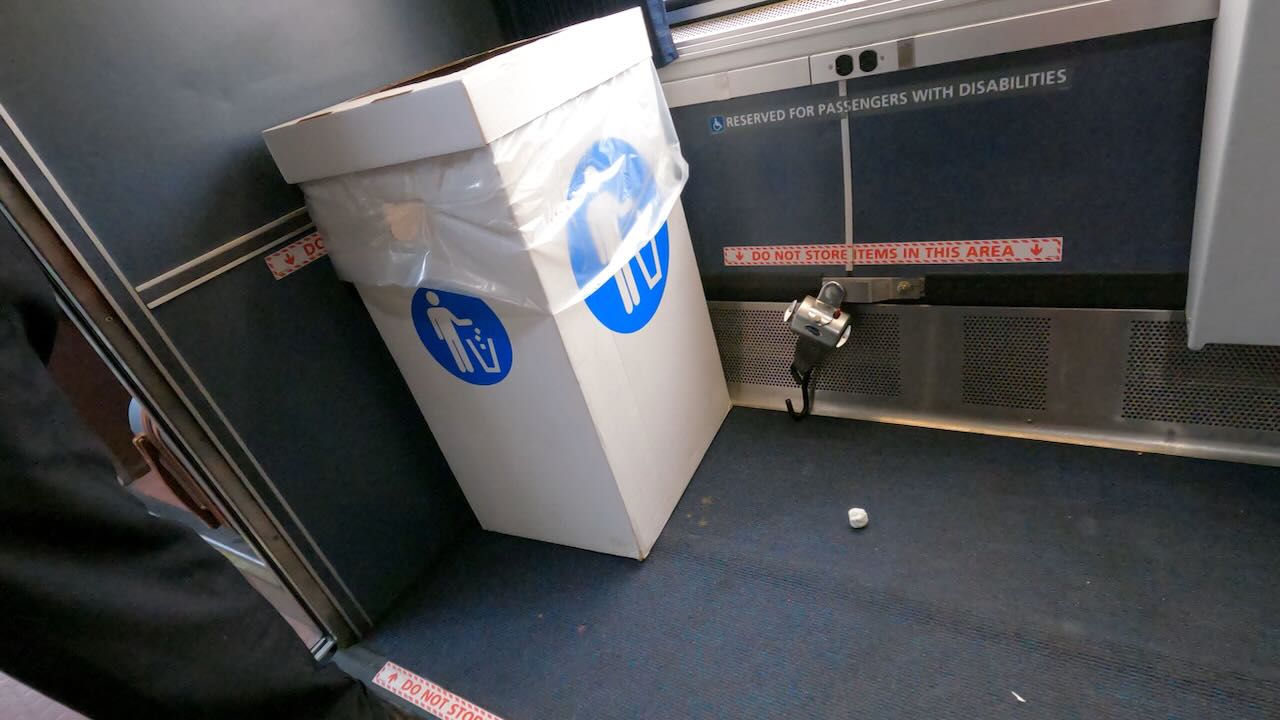How Amtrak can improve the booking, boarding, and riding experience for Disabled travelers
May 2025

We're two Disabled people who like to travel, and riding Amtrak trains is a major part of our adventures.
For us, Amtrak is both a way to get places and a destination in itself. As a couple, we've ridden 22 Amtrak trains on 8 routes across all classes (coach, business, and private room). We've ridden coast to coast from California to New York and back, taking the California Zephyr, Lakeshore Limited, and Acela. We've traveled through the heart of the country on the Texas Eagle and Crescent. We've been along the west coast on the Coast Starlight and Pacific Surfliner. We plan our trips around taking Amtrak routes we haven't ridden before.
Along the way, we've collected suggestions for making Amtrak a better experience for Disabled passengers. Aubrie has muscular dystrophy, is hard of hearing, and rides a power wheelchair, and Peter has low vision. We'll describe what we've noticed about (1) booking, (2) boarding and deboarding, and (3) riding Amtrak trains.
1. Booking is harder for a "Passenger with Disability" than for passengers without disabilities.
Finding and buying accessible-seating tickets is laborious, no matter whether we're using the website, app, or phone system.
The site blocks Disabled customers from multi-trip searches, and it demands repetitive typing and clicking.
When we plan complicated cross-country routes among multiple cities, we prefer to use the website on a computer.

The "Passenger with Disability or Assistance Needed?" checkbox is only available when searching between two cities.

When "Add Trip" is clicked for multi-city searching, the "Passenger with Disability or Assistance Needed?" checkbox disappears.
We use the "Passenger with Disability" checkbox to ensure accessible seating or accessible rooms. However, the website does not allow a "Passenger with Disability" to do a multi-city trip search, so the site design forces us to start a new search for each leg of the trip.
Every time we do a search, we have to confirm Aubrie's accessible travel information as Traveler 1, type in Peter Saathoff-Harshfield's first and last names as Traveler 2 for no apparent reason (later on, during booking confirmation, we will have to input each of our names anyway), and check a box to consent to have the information shared with Amtrak, even though we have already elected to save the information to Aubrie's profile.
For someone with muscular dystrophy, every click is taxing; ironically, someone who has a disability must perform many more clicks than someone who is not disabled.
Suggestions:
- Allow the "Passenger with Disability" option on multi-city trip searches.
- If someone has elected to save accessible travel information to their profile, do not ask them to confirm and consent again.
- Do not require a Passenger with Disability (designated as Traveler 1) to input the name of Traveler 2 until booking confirmation.
The site and app are broken for screen reader users.
Both the website on a computer and the app on a phone are difficult to use with a screen reader, particularly during the booking process. Peter has encountered many unlabeled buttons and parts of the page that appear visually but aren't possible to access with the screen reader, making it almost impossible to independently and confidently book a trip.
(We almost never use the phone system anymore because it's extremely slow, difficult to hear, and difficult to be understood.)
Suggestion:
- Involve blind screen reader users in the development of and improvements to the website and app.
Coupons don't work for accessible tickets.
With our high volume of travel, we've earned coupons. However, we have never been able to use these coupons as passengers with disabilities. When we rode the Acela, we wanted to use our "One-Class Upgrade" coupons, but even when we struggled through the arduous phone tree to speak to a representative, they were unable to apply the coupons to our accessible tickets.
Suggestion:
- Allow passengers with disabilities to use the coupons they have earned.
2. Boarding and deboarding sideline Disabled passengers.
Ideally, wheelchair riders are able to roll directly onto trains without any assistance, because the platform meets the floor of the train with a minimal gap. This is called level boarding or step-free boarding. No Amtrak train we've ridden has this. Instead, for Aubrie to roll on or off the train, we must wait for a conductor to deploy a lift or put down a ramp.
Suggestion for the long term:
- Implement level boarding for trains and stations.
Lifts are a second-class experience.
The lifts have a flap that the conductors often let slam on the ground. This is painful to the ear and makes Aubrie feel treated like freight instead of a customer.
Video of a lift flap slamming and bouncing loudly on the floor.
Suggestion:
- Educate conductors on putting the lift flap down gently when possible.
Even when we're first in line, conductors tell us to wait until everyone else goes first.

People with their rolling luggage crowd around the ramp to board before Aubrie can. The conductors stand to the side.
When conductors put down the ramps, they often tell Aubrie to wait and let all other passengers board before she does. This presents problems:
- The passengers ahead of her proceed to put their luggage in the wheelchair space.
- Other passengers take the seats near the wheelchair space, so we have to ask someone to move so Peter can sit near Aubrie.
These problems can be avoided if Disabled passengers are allowed to board first. We are hard-pressed to find any reason not to allow Disabled passengers to board first, since the overall boarding time is the same.

Two rolling luggages occupy the space marked as "♿ RESERVED FOR PASSENGERS WITH DISABILITIES".
Suggestion:
- Board Disabled passengers first.
Wheelchair riders can't get out when others can.
On long-distance routes, the train has several long stops at which most passengers are allowed to get out and walk around. At these stops, Peter carries Aubrie out of the train, because no conductor has ever offered to put the ramp down.

View out the train window of Peter carrying Aubrie around the San Luis Obispo station. Other passengers walk and wait around in the background.
Suggestion:
- Have conductors offer to put down the ramp at long stops.
3. Riding is the best part, but it could be safer and more enjoyable.
Long-distance routes are beautiful, and they come without many of the stresses of airplane travel. Amtrak is aware that many parts of the trains are not wheelchair-accessible, including the observation cars for which they are known. Since Aubrie can't go to the observation car, it would be nice if the windows of the accessible room were kept cleaner.
Beds on Superliners feel like traps.
Of all the parts of traveling on Amtrak, sleeping on the Superliners is the most difficult aspect for Aubrie. Aubrie has profound, progressive muscle weakness. Even in the accessible room, the bed is very narrow and has no handles for Aubrie to turn herself to relieve pain and prevent pressure sores. Peter must sleep in the upper bunk, which is not easy to quickly get into and out of, and the loudness of the train make it difficult for him to hear Aubrie call for help.
We really like the accessible rooms on the Viewliners because the lower bed is wide enough (though just barely) for Peter to sleep next to Aubrie and help her turn.
Suggestions:
- Near-term: Add handles along the lower bed in the Superliner accessible rooms.
- Long-term: Make beds wider.
- Long-term: Make trains in which all parts are wheelchair-accessible, including bathrooms, showers, dining cars, cafe cars, and observation cars.
Conductors use the wheelchair space for trash storage.
In coach and business, Aubrie has boarded the train to find that employees have put a trash can in the wheelchair section.

A large trash can blocks one of three signs that say, "DO NOT STORE ITEMS IN THIS AREA". A sign on the wall says, "♿ RESERVED FOR PASSENGERS WITH DISABILITIES". An escapee ball of trash sits on the floor of the wheelchair space.
Suggestions:
- Near-term: Educate conductors on never putting trash cans in the wheelchair section, not even temporarily.
- Long-term: Design trains with appropriate trash storage.
Food information is inaccessible, and food options are limited.
Since Peter can't read by sight, and no Braille or accessible digital menu has been available to him, he has to rely on Aubrie or an attendant to read the options, which reduces his autonomy. While the Amtrak website does have PDFs of menus, these are not an accessible format. The Amtrak website makes no mention of Braille menus.
Aubrie and Peter follow mostly vegan or pescatarian diets. It has been a challenge both to know what allergens a dish contains, and to stay nourished with enough food that meets our requirements.
On long-distance routes, we find ourselves eating baked potatoes with chili for every lunch (it is rather delicious, we must admit). While we don't have life-threatening food restrictions, many people do, and the lack of clear allergen information and allergen-free options is concerning.
Suggestions:
- Offer accessible menus in Braille and accessible digital formats (PDFs don't count).
- Aim for 50% vegan and allergen-free options for appetizers, entrées, and desserts.
We already choose Amtrak. Now we want to be able to recommend it.
We're Amtrak fans. We save and reuse Amtrak-branded disposable cups. Amtrak has taken us to some of the most meaningful moments of our lives, like family reunions, visits with old friends, and the total solar eclipse of April 2024. We believe in passenger rail, and we want Disabled travelers to have an easier and more enjoyable time booking, boarding, and riding Amtrak.
Changes like a smoother trip search for passengers with disabilities, adjustments to conductors' protocols, and a focus on fully accessible trains would go a long way in making Amtrak a world-class experience for Disabled travelers.

We have more train trips planned this summer, and as we ride Amtrak in the future, we hope to see some of the improvements we've taken the time to suggest.